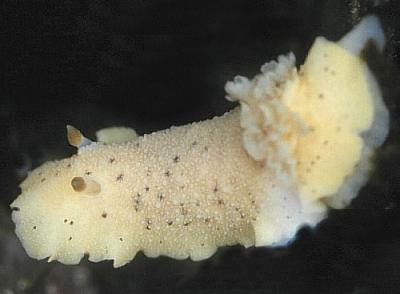Sea Lemon mimicry complex?
October 23, 2000
From: Jeff Goddard

Hi Bill,
The Forum has been on the subject of the so called Sea Lemons lately, and we have seen how closely some of these species resemble one another externally (Archidoris montereyensis and Anisodoris nobilis especially are confused for one another). I would like to suggest that Archidoris montereyensis, Anisodoris nobilis, Geitodoris heathi, Anisodoris lentiginosa, the yellow form of Archidoris odhneri, Aldisa cooperi, and yellow forms of the keyhole limpet Fissurellidea bimaculata are part of a mimicry complex which confers protection from visual predators, especially when an individual is off its sponge prey and out in the open. On their prey, most of these species are quite cryptically colored. While the resemblance between most of these species is pretty superficial, it may be enough to ward off a foraging fish already familiar with the noxious qualities of one of them.
Excepting the yellow form of Archidoris odhneri, which I don't have a photo of, I have enclosed photos of the species mentioned above which are not yet pictured on the Forum.
[PHOTOS: Specimens were all collected at Cape Arago, Oregon: UPPER RIGHT: Geitodoris heathi, March 1986. LOWER LEFT: Fissurellidea bimaculata November 1986. LOWER RIGHT: Aldisa cooperi, June 1981]
Best wishes,
Jeff
goddard@lifesci.ucsb.edu


Thanks Jeff,
There have been some interesting articles written on mimicry. What we need to be careful of is separating the phenomenon of 'looking alike' from the biological process we call mimicry - a process in which one or more species evolve to look like another species (the model). The biggest hurdle to identifying examples of mimicry, let alone studying it, is to find the predator - prey relationships which drive the evolutionary processes of selection needed to bring about similarities in shape and colour pattern. Unless they can be identified it is very difficult to determine which examples of 'looking alike' are the result of chance, and which are the result of evolutionary selection.
Thanks again for the interesting photos and for raising this interesting idea.
Best wishes
Bill Rudman.
Related messages
-
White and yellow variation of Geitodoris heathi
From: John Yasaki, September 2, 2008 -
White variation of Geitodoris heathi
From: Robert Lee, July 28, 2007 -
Geitodoris heathi from Monterey, California
From: Clinton Bauder, April 27, 2006 -
Geitodoris heathi from the Channel Ids, California
From: Bruce Wight , August 8, 2003 -
Re: Geitodoris heathi? from California
From: Dave Behrens, August 14, 2002 -
Geitodoris heathi? from California
From: Clinton Bauder, August 10, 2002 -
Geitodoris heathi? from California
From: Clinton Bauder, June 27, 2002
